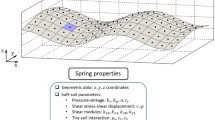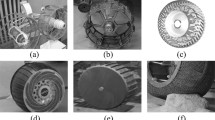Abstract
Today’s growing scientific interest in extraterrestrial bodies increases the necessity of extended mobility on these objects. Thus, planetary exploration systems are facing new challenges in terms of mission planning as well as obstacle and soil traversability. In order to fit the tight schedules of space missions and to cover a large variety of environmental conditions, experimental test setups are complemented by numerical simulation models used as virtual prototypes. In this context we present an integrated simulation environment which allows for using different available contact models, ranging from simple but real-time capable approximations based on rigid-body modeling techniques up to very accurate solutions based on Discrete Element Method (DEM). The models are explained and classified for their applications. For this work, a one-point Bekker based approach (BCM) and the so-called Soil Contact Model (SCM), which is a multi-point extension of the Bekker–Wong method taking soil deformation into account, are used for further analysis. These two contact models are applied for homogeneous simulations with only one type of contact model for all wheels as well as for a heterogeneous multi-tiered simulation with different contact models for the wheels. It will be shown that the multi-tiered approach enhances the simulation result accuracy compared to the results of a homogeneous model with a low level of detail while speeding up the simulation in comparison to a homogeneous higher-tier model.
Access this chapter
Tax calculation will be finalised at checkout
Purchases are for personal use only
Similar content being viewed by others
References
Krenn R, Hirzinger G (2008) Simulation of rover locomotion on sandy terrain-modeling, verification and validation. In: 10th ESA workshop on advanced space technologies for robotics and automation–ASTRA, (2008) Noordwijk. Niederlande, ESA
Lichtenheldt R, Hellerer M, Barthelmes S, Buse F (2015) Heterogeneous, multi-tier wheel ground contact simulation for planetary exploration ISBN 978-84-944244-0-3
Elmqvist H, Mattsson SE, Otter M (1999) Modelica a language for physical system modeling, visualization and interaction. In: Proceedings of the 1999 IEEE international symposium on computer aided control system design (Cat. No.99TH8404)
Hellerer M, Bellmann T, Schlegel F (2014) The DLR Visualization Library Recent development and applications. In: Proceedings of the 10th international modelica conference–Lund, Sweden - Mar 10–12, 2014, pp 899–911
Erleben K (2004) Stable, robust, and versatile multibody dynamics animation. Phd thesis, University of Copenhagen, Denmark
Mirtich BV (1996) Impulse-based dynamic simulation of rigid body systems. Dissertation, University of California at Berkeley
Bender J, Erleben K, Trinkle JC (2014) Interactive simulation of rigid body dynamics in computer graphics. Comput Gr Forum 33(1):246–270
Cottle RW, Dantzig GB (1968) Complementary pivot theory of mathematical programming. Linear Algebra Appl 1(1):103–125
Boeing A, Bräunl T (2007) Evaluation of real-time physics simulation systems. In: Proceedings of the 5th international conference on computer graphics and interactive techniques in Australia and Southeast Asia, ACM pp 281–288
Marhefka DW, Orin DE (1996) Simulation of contact using a nonlinear dam** model. Proc IEEE Int Conf Robot Autom 2(April):1662–1668
Lichtenheldt R, Schäfer B, Krömer O (2014) Hammering beneath the surface of mars—modeling and simulation of the impact-driven locomotion of the hp3-mole by coupling enhanced multi-body dynamics and discrete element method. In: Sha** the future by engineering: 58th Ilmenau scientific colloquium IWK, URN (Paper): http://nbn-resolving.de/urn:nbn:de:gbv:ilm1-2014iwk-155:2 Technische Universität Ilmenau, 08–12 Sept 2014
Vivake Asnani, Damon Delap, Colin Creager (2009) The development of wheels for the Lunar Roving Vehicle. J Terramech 46(3):89–103
Trease B, Arvidson RE, Lindemann R, Bennett K, Feng Z, Iagnemma K, Senatore C, Van Dyke L (2011) Dynamic modeling and soil mechanics for path planning. In: Proceedings of the ASME 2011 international design engineering technical conference & computers and information in engineering conference IDETC/CIE, pp 1–11
Iagnemma K, Senatore C, Trease B (2011) Terramechanics modeling of Mars surface exploration rovers for simulation and parameter estimation. In: Proceedings of the IDETC/CIE 2011 ASME international design engineering technical conferences & computers and information in engineering conference, pp 1–8
Wong JY (2008) Theory of ground vehicles, 4th edn. Wiley, New Jersey
Terzaghi K, Peck RB, Mesri G (1996) Soil mechanics in engineering and practice. Wiley, New Jersey
Fabian Buse (2015) Masterarbeit Machbarkeitsstudie für einen roboterbasierten Radprüfstand zur Entwicklung von Mars Mondrovern. Masterthesis, RWTH Aachen
Krenn R, Hirzinger G (2009) SCM a soil contact model for multi-body system simulations. In: 11th European regional conference of the international society for terrain-vehicle systems–ISTVS 2009, Bremen, Germany
Sumner RW, O’Brien JF, Hodgins JK (1999) Animating sand, mud, and snow. Comput Gr Forum 18:17–26
Zhou F, Arvidson RE, Bennett K, Trease B, Lindemann R, Bellutta P, Iagnemma K, Senatore C (2014) Simulations of mars rover traverses. J Field Robot 31(1):141–160
Holz D, Azimi A, Teichmann M, Kovecses J (2012) Mobility prediction of rovers on soft terrain: effects of wheel- and tool-induced terrain deformations. Proceedings of the fifteenth international conference on climbing and walking robots and the support technologies for mobile machines CLAWAR 2012:647–654
Krenn R, Gibbesch A, Binet G, Bemporad A (2013) Model predictive traction and steering control of planetary rovers. In: 12th symposium on advanced space technologies in robotics and automation: ASTRA 2013
Cundall PA, Strack ODL (1979) A discrete numerical model for granular assemblies. Geotechnique 29:47–65
Obermayr M (2013) Prediction of load data for construction equipment using the discrete element method. PhD thesis, Universität Stuttgart
Nakashima H, Oida A, Momozu M, Kawase Y, Kanamori H (2007) Parametric analysis of lugged wheel performance for a lunar microrover by means of dem. J Terramech 44(2):153–162
Knuth MA, Johnson JB, Hopkins MA, Sullivan RJ, Moore JM (2011) Discrete element modeling of a mars exploration rover wheel in granular material. J Terramech
Das N (2007) Modeling three-dimensional shape of sand grains using discrete element method. PhD thesis, University of Florida
Li W, Huang Y, Cui Y, Dong S, Wang J (2010) Trafficability analysis of lunar mare terrain by means of the discrete element method for wheeled rover locomotion. J Terramech 47(3):161–172
Oda M, Iwashita K (2000) Study on couple stress and shear band development in granular media based on numerical simulation analyses. Int J Eng Sci 38:1713–1740
Plassiard J-P, Belheine N, Donze F-V (2007) Calibration procedure for spherical discrete elements using a local moment law. Technical report, Universität Grenoble
van der Linde J (2007) Discrete element modeling of a vibratory subsoiler. Master’s thesis, University of Stellenbosch, Department of Mechanical and Mechatronic Engineering
Asaf Z, Rubinstein D, Shmulevich I (2006) Evaluation of link-track performances using dem. J Terramech 43(2):141–161
Harada T, Tanaka M, Koshizuka S, Kawaguchi Y (2007) Real-time coupling of fluids and rigid bodies. In APCOM, Kyoto
Li A, Melanz D, Serban R, Negrut D (2014) A gpu-based preconditioned newton-krylov solver for flexible multibody dynamics. In: 3rd joint international conference on multibody system dynamics, IMSD 2014, Busan, Korea
Negrut D, Tasora A, Anitescu M, Mazhar H (2011) Solving large multi-body dynamics problems on the GPU. In: GPU Gems, pp 269–280
Kleinert J, Obermayr M, Balzer M (2013) Modeling of large scale granular systems using the discrete element mehtod and the non-smooth contact dynamics method: a comparison. In: ECCOMAS multibody dynamics pp 1–4 July, University of Zagreb, Kroatien
Melanz D, Mazhar H, Negrut D (2014) Gauging military vehicle mobility through many-body dynamics simulation. In: The 3rd joint international conference on multibody system dynamics (IMSD 2014), Busan, Korea
Fleissner F (2012) Dokumentation, template-files und beispiele zum programmpaket “pasimodo”. Inpartik & Universität Stuttgart, Template files
Lichtenheldt R, Schäfer B (2013) Planetary rover locomotion on soft granular soils - efficient adaption of the rolling behaviour of nonspherical grains for discrete element simulations. In: 3rd international conference on particle-based methods, pp 807–818, ISBN 978-84-941531-8-1, Stuttgart
Lichtenheldt R (2015) A novel systematic method to estimate the contact parameters of particles in discrete element simulations of soil. In: 4th international conference on particle-based methods - particles 2015, pp 430-441, ISBN 978-84-944244-7-2, Barcelona
Lichtenheldt R, Schäfer B (2013) Planetary rover locomotion on soft granular Soils–efficient adaption of the rolling behaviour of nonspherical grains for discrete element simulations. In: 3rd international conference on particle-based methods, pp 807–818, ISBN 978-84-941531-8-1, Stuttgart, Germany
Lichtenheldt R, Schäfer B, Olaf K (2014) Hammering beneath the surface of mars–modeling and simulation of the impact-driven locomotion of the HP3-Mole by coupling enhanced multi-body dynamics and discrete element method. In: 58th Ilmenau scientific colloquium (IWK), Ilmenau, Germany, Technische Universität Ilmenau
Lichtenheldt R, Schäfer B (2013) Locomotion on soft granular soils: a discrete element based approach for simulations in planetary exploration. In: 12th symposium on advanced space technologies in robotics and automation: ASTRA 2013, Noordwijk, the Netherlands
Barnerdt WB et al. (2013) Insight: a discovery mission to explore the interior of mars. In: 44th lunar and planetary science conference, Texas, USA
Spohn T, Grott M, Smrekar S, Krause C, Hudson TL (2014) Measuring the martian heat flow using the heat flow and physical properties package (hp3). In: 45th lunar and planetary science conference
Lichtenheldt R (2015) Hammering beneath the surface of Mars–Analyse des Schlagzyklus und der äußeren Form des HP3-Mole mit Hilfe der Diskrete Elemente Methode. In: IFToMM D-A-CH 2015, Dortmund, Germany ISBN 978-3-940402-03-5
Lichtenheldt R, Schäfer B (2013) Locomotion on soft granular soils: a discrete element based approach for simulations in planetary exploration. In: 12th symposium on advanced space technologies in robotics and automation, ESA/ESTEC, Netherlands
Wedler A, Rebele B, Reill J, Suppa M, Hirschmüller H, Brand C, Schuster M, Vodermayer B, Gmeiner H, Maier A, Willberg B, Bussmann K, Wappler F, Hellerer M, Lichtenheldt R (2015) LRU - lightweight rover unit. In Proceedings of the 13th symposium on advanced space technologies in robotics and automation (ASTRA)
Wedler A, Hellerer M, Rebele B, Gmeiner H, Vodermayer B, Bellmann T, Barthelmes S, Lange C, Witte L, Schmitz N, Knapmeyer M, Czeluschke A, Thomsen L, Waldmann C, Wilde M, Takei Y (2015) Robex components and methods for the planetary exploration demonstration mission (1). In: 13th symposium on advanced space 820 technologies in robotics and automation, ESA/ESTEC, Netherlands
Apfelbeck M, Kuß S, Rebele B, Schäfer B (2011) A systematic approach to reliably characterize soils based on bevameter testing. J Terramech Elsevier 48:360–371
Dahlquist G (1963) A special stability problem for linear multistep methods. BIT 3(1):27–43
Lichtenheldt R, Schäfer B, Krömer O, van Zoest T (2014) Hammering beneath the surface of Mars - forensic engineering of failures in the HP3-Mole by applying multi-body dynamics simulation. In: Proceedings of 3rd international conference on multibody system dynamics IMSD 2014, ISBN 978-89-950027-7-3, Busan, Korea
Acknowledgments
Parts of this work have been granted by the Helmholtz-Gemeinschaft Deutscher Forschungszentren e.V. under contract number HA-304 (Robotic Exploration of Extreme Environments—ROBEX)
Author information
Authors and Affiliations
Corresponding author
Editor information
Editors and Affiliations
Rights and permissions
Copyright information
© 2016 Springer International Publishing Switzerland
About this chapter
Cite this chapter
Lichtenheldt, R., Barthelmes, S., Buse, F., Hellerer, M. (2016). Wheel-Ground Modeling in Planetary Exploration: From Unified Simulation Frameworks Towards Heterogeneous, Multi-tier Wheel Ground Contact Simulation. In: Font-Llagunes, J. (eds) Multibody Dynamics. Computational Methods in Applied Sciences, vol 42. Springer, Cham. https://doi.org/10.1007/978-3-319-30614-8_8
Download citation
DOI: https://doi.org/10.1007/978-3-319-30614-8_8
Published:
Publisher Name: Springer, Cham
Print ISBN: 978-3-319-30612-4
Online ISBN: 978-3-319-30614-8
eBook Packages: EngineeringEngineering (R0)




